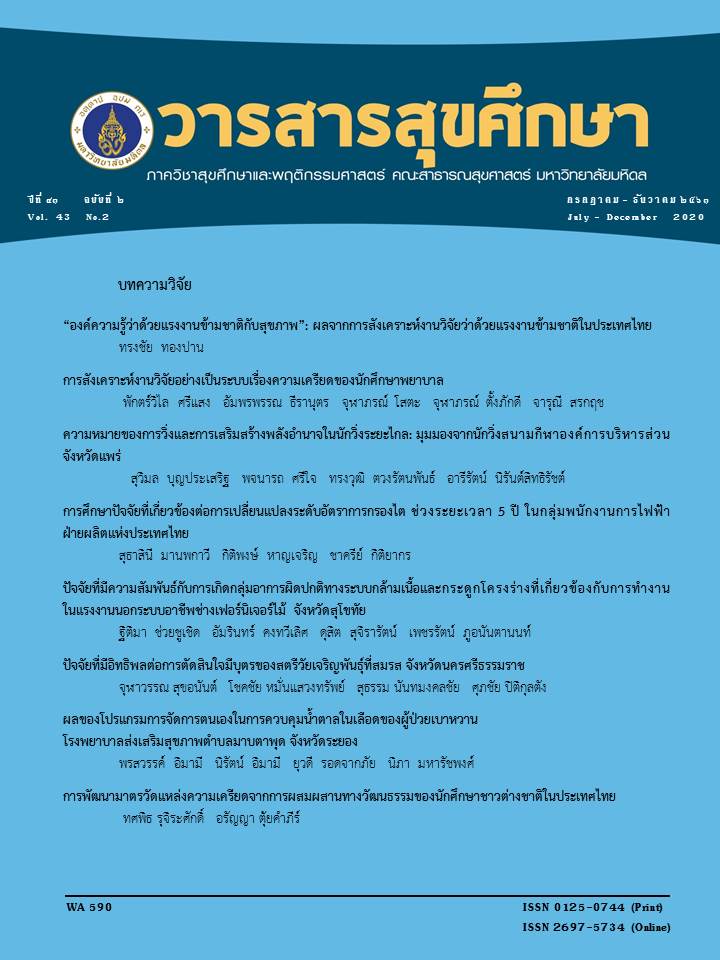The Study of Factors Associated with Change in Glomerular Filtration Rate over 5 Year among Employees of the Electricity Generating Authority of Thailand
Main Article Content
Abstract
The Follow up study intend to identify factors that associated of the change in estimated glomerular filtration rate in 5-year period of following employees of the Electricity Generating Authority of Thailand. This retrospective cohort study obtained data EGAT 1 and 2 cohort study. This study included 4,835 participants for analysis. The samples were aged between 33-66 years. Changes in estimated glomerular filtration rate were estimated using CKD-EPI creatinine equation. Estimated glomerular filtration rate was classified eGFR into 4 categories: (1) increase >15%, (2) stable within ±15%, (3) minor decline (decline 15-25%), and (4) definite decline (decline >25%). After adjusting for covariates in sex and age group, the multivariable logistic regression model estimated that 5 risk factors associated with the definite eGFR decline significantly in 5 years. The study cohort demonstrated that 1) Education less than 12 year (OR adjusted 1.28, 95%CI 1.07-1.54); 2) Alcohol(Drinking) (OR adjusted 1.56, 95%CI 1.13-2.15); 3) Diabetes (OR adjusted 2.28, 95%CI 1.61-3.23); 4) Hypertension (OR adjusted 1.88, 95%CI 1.39-2.54); and 5) Proteinuria Positive (OR adjusted 1.52, 95%CI 1.16-1.99). All 5 risk factor were related to definite eGFR decline, defined as more than 25% than those who had stable eGFRcr (defined as ±15% change), with p<0.05. This study about the risk factors associated with change in estimated glomerular filtration rate (eGFR) prevent the deterioration of kidney, promote change behavior and reduce risk of complications.
Article Details
References
กระทรวงสาธารณสุข. การเข้าถึงบริการทดแทนไตอย่างถ้วนหน้าในประเทศไทย. สำนักงานพัฒนานโยบายสุขภาพระหว่างประเทศ กระทรวงสาธารณสุข. 2012:1-12.
Kim HO, Chae S-Y, Baek S, Moon DH. Factors affecting changes in the glomerular filtration rate after unilateral nephrectomy in living kidney donors and patients with renal disease. Nuclear medicine and molecular imaging 2010;44(1):69-74.
Vathesatogkit P, Woodward M, Tanomsup S, Ratanachaiwong W, Vanavanan S, Yamwong S, et al. Cohort Profile: The electricity generating authority of Thailand study. International Journal of Epidemiology 2012;41(2):359-365.
Martin SS, Blaha MJ, Elshazly MB, Toth PP, Kwiterovich PO, Blumenthal RS, et al. Comparison of a novel method vs the Friedewald equation for estimating low-density lipoprotein cholesterol levels from the standard lipid profile. JAMA 2013;310(19):2061-2068.
Mohprasit K. Evaluation of estimated glomerular filtration rate (eGFR) by reference range of serum creatinine at Buddhachinaraj Phitsanuloke Hospital. 2013.
Shara NM, Wang H, Mete M, Al-Balha YR, Azalddin N, Lee ET, et al. Estimated GFR and incident cardiovascular disease events in American Indians: the Strong Heart Study. Am J Kidney Dis 2012;60(5):795-803.
Shlipak MG, Matsushita K, Ärnlöv J, Inker LA, Katz R, Polkinghorne KR, et al. Cystatin C versus Creatinine in Determining Risk Based on Kidney Function. N Engl J Med 2013;369(10):932-943.
Perkins RM, Bucaloiu ID, Kirchner HL, Ashouian N, Hartle JE, Yahya T. GFR Decline and Mortality Risk among Patients with Chronic Kidney Disease. CJASN 2011;6(8):1879-1886.
O. Eriksen B, Stefansson V, G. Jenssen T, Mathisen U, Schei J, D. Solbu M, et al. Blood pressure and age-related GFR decline in the general population. BMC Nephrology 2017;18(77):1-9.
Donfrancesco C, Palleschi S, Palmieri L, Rossi B, Lo Noce C, Pannozzo F, et al. Estimated glomerular filtration rate, all-cause mortality and cardiovascular diseases incidence in a low risk population: the MATISS study. Plos One 2013;8(10):e78475-e.
Pan C-s, Ju TR, Lee CC, Chen Y-P, Hsu C-Y, Hung D-Z, et al. Alcohol use disorder tied to development of chronic kidney disease: A nationwide database analysis. PLOS ONE 2018;13(9):e0203410.
Duan J, Wang C, Liu D, Qiao Y, Pan S, Jiang D, et al. Prevalence and risk factors of chronic kidney disease and diabetic kidney disease in Chinese rural residents: a cross-sectional survey. Scientific Reports 2019;9(1):10408.
Adjei DN, Stronks K, Adu D, Snijder MB, Modesti PA, Peters RJG, et al. Relationship between educational and occupational levels, and Chronic Kidney Disease in a multi-ethnic sample- The HELIUS study. PloS one 2017;12(11):e0186460-e.


